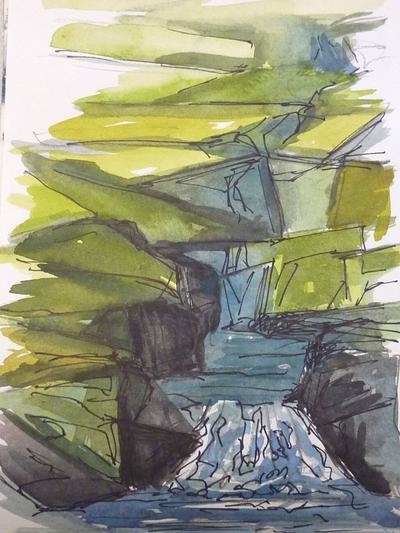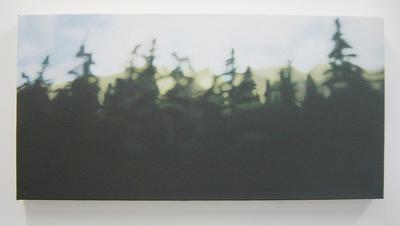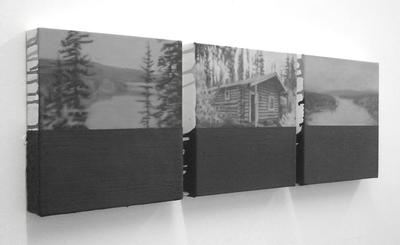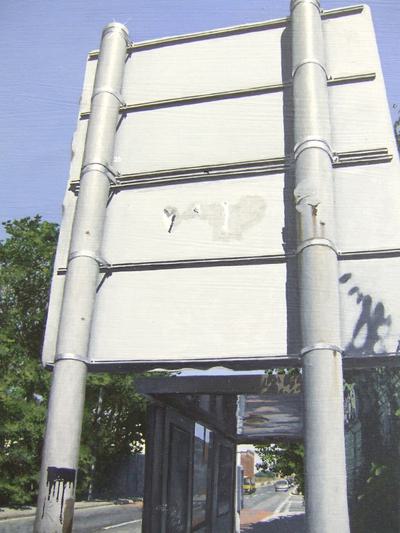Clive Brandon

My practice responds to the landscapes, architecture, spaces, and places I inhabit and explore, drawing upon my deep connection to the environment. Recent work focuses on the concept of the ‘constructed landscape,’ exploring how human intervention shapes and reshapes natural spaces.
Through an experimental and often improvised process, I use a diverse range of materials, including found objects like cardboard, scrap wood, and paper, combined with watercolour, charcoal, and newsprint. My pieces evoke both real and imagined landscapes, grounded in my surroundings yet speaking to broader questions about our relationship with nature. These works are informed by the Japanese aesthetic of wabi sabi, celebrating imperfection and impermanence, as well as ‘Casualist’ art influences, creating lo-fi pieces that embrace the beauty of the unfinished and the temporary. Light and space are integral to my work. The space within and between the work allows the viewer to occupy it, much like the experience of being in the actual landscape. It extends beyond the confines of a canvas or frame, beyond peripheral vision, offering a breathing space akin to a walk—thinking, looking, pausing. The viewer navigates the work in much the same way one reads a map or a book, moving through the clues of landscape and topography.
Since relocating from the city to the Scottish Highlands in 2015, my work has become more attuned to the rhythms of the landscape. My creative process is now intertwined with the changing seasons and the ever-shifting environment. The varying energies of spring, summer, autumn, and winter shape my work, and I aim to reflect this cyclical nature in my practice. This approach also aligns with my awareness of the ongoing climate and ecological crisis, prompting me to consider how my art can engage with these urgent global issues.
As a regenerative gardener, I explore connections between permaculture, site-specificity, and constructed landscapes. Both my gardening and artistic practices are rooted in observation, pattern recognition, and the mapping of natural cycles—weather patterns, seasonal changes, and landscape transformations. My work reflects these interconnected processes, with an emphasis on closed loops, circular systems, and sustainable practices.
My work draws inspiration from contemporary and historical artists and movements, including the Land Art and Minimalism of Robert Smithson and Ian Hamilton-Finlay, the Anarchitecture of Gordon Matta-Clark, the surreal pastoral landscapes of Paul Nash, and the 1950s works of Joan Eardley and Francis Davison. I also find resonance in the practices of contemporary artists such as David Lemm, Tony Swain, Emily Speed, Helen O’Leary, and Louise Barrington.
Through my art, I invite viewers to consider the landscapes we inhabit—not only as physical spaces but as constructs shaped by human hands.
Born 1970 UK, lives on Black Isle, Scotland
1993 – 1996 De Montfort University, Leicester, BA Fine Art & Art History
2006 – 2008 Wimbledon College of Art, London, MA Fine Art (Part Time/AHRC funded)
2025 Creative Practice 4 (Part Time), Moray School of Art
Solo Exhibitions
2015 Travelogue/Northern European Residencies 2013-14, The Briggait, Glasgow
2011 Strategies, Contingencies & Failures, Galerie Hubert Baechler, Zurich, CH
2007 Work Makes Dust, Galerie Hubert Baechler, Zurich, CH
2004 3 Route Dislocation, Galerie Hubert Baechler, Zurich, CH
Selected Group Exhibitions
2025 Mind The Gap, Moray School of Art, Elgin, UK
2018 Trace Ingredients (collaboration with Cat Meighan), IMAG, Inverness, UK
2017 Lonely Art Club, IMAG, Inverness, UK
2014 AxisWeb, London Art Fair, London, UK
2012 End of the Future, Transition Gallery, London, UK
2012 Jam Tomorrow, APT Gallery, London, UK
2011 Crash Open Salon, Charlie Dutton Gallery, London, UK
2011 Points of Non-Interest, Mint Hotel, London, UK (in association with Whitechapel Gallery and London Met MA Curating Course)
2009 I can bring this to your city, Island Projects London, UK
2009 Olympic Visions, The Nunnery, London, UK
2008 New Territories, Ada St Gallery, London, UK
2008 Matter of Time, James Taylor Gallery, London, UK
2008 Signs of Life, Offsite Project, London, UK
2008 M is for MA, Wimbledon College of Arts, London, UK
2008 Approaches to What?, The Nunnery, London, UK
2008 The Best Is Yet To Come, Galerie Hubert Baechler, Zurich, CH
2007 Currents, Trinity Buoy Wharf, London, UK
2006 PreviewBerlin, Backfabrik, Berlin, DE
2006 Points of Non-Interest, Guest artist of WalkWalkWalk, London, UK
2005 Acid Drops and Sugar Candy, Transition Gallery, London, UK
2005 The Wrong Map, Three Colts Gallery, London, UK, (curated by C A Brandon) 2004 E9: An Anatomy of an Area, Transition Gallery, London, UK
2003 Sense & Sensibility, Transition Gallery, London, UK
1999 999, Troesch Building, Bellinzona, CH
Residencies and Workshops
2016/17/18/19 ‘Sketchiness’ urban sketching workshop in Inverness as part of Festival of Architecture
2017 Exchange Residency North,Victorian Market, Inverness, Scotland
2016 Exchange Residency North, The Clay Studio, Inverness, Scotland
2014 WASPS The Booth, Shetland
2014 AiR Hafnarborg, The Hafnarfjordur Centre of Culture and Fine Art, Iceland
2013 AiR Ricklundgarden, Saxnas, Sweden
2013 AiR Konstepidemin, Goteborg, Sweden
2013 WASPS The Steeple, Newburgh, Scotland
2013 Artist in Residence at KINOKINO Centre for Art and Film, Sandnes, Norway
Publications 2004 E9: An Anatomy of an Area Catalogue ISBN 0-09548954-0-1
Helping Artists Keep Going
Axis is an artist-led charity supporting contemporary visual artists with resources, connection, and visibility.














